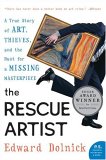Reading Guide Questions

Please be aware that this discussion guide will contain spoilers!
Introduction
Edward Dolnick has done a terrific job in
The Rescue Artist of
opening up all the elements of a specific event-the theft of Edward Munch's
famous painting
The Scream - and bringing them together like a skilled
choreographer, resulting in a great reading experience. This book has it all:
truth, suspense, humor, in-depth analysis, great characterizations, wonderful
writing, and a truly interesting look at civilization in all its layers.
When thieves climbed a ladder into the National Gallery of Oslo, Norway in 1994
and made off with
The Scream, a national treasure and an international
cultural icon, a drama was set into motion that is better than any fictional
crime novel or screenplay. Dolnick explores the history of art theft, and the
kind of people involved, from all sectors of society, with an ear for great
dialogue as great as Hitchcock's, and an eye for detail as finely tuned as any
painter.
He introduces the reader to Charles Hill, the detective who solved this crime,
and a character so fascinating that he rivals any fictional detective for
bravado, complexity, risk-taking and ethics. Hill is a rarity, an officer of the
law who has a deep understanding of and passion for art. He cares far more about
the masterpieces that he tracks than about pursuing the thieves who steal them
and Dolnick makes the reader understand why. As the story develops, we are left
on the edge of our seats as Dolnick explores the themes of culture, class,
crime, police, crooks and the world they share. Ultimately this book is no mere
"who-dunnit," but an accomplished and fascinating look into the value of art in
western culture, and the ways in which it affects the daily lives of even the
most ordinary citizens. It's impossible to read this book without learning a
great deal about art, about crime, and about desire, all the while having a
great time.
Questions for Discussion
- Were you shocked to find out what an easy time thieves seem to have in
stealing paintings worth millions of dollars? It seems to be so easy, and
yet Dolnick tells us that the thieves rarely manage to profit from these
crimes. What are some of the things that motivate them to keep doing it? Did
these reasons ring true to you?
- What are some of the characteristics that the world of crime and world
of law enforcement seem to share? In this book, which world seemed to be the
most effective, and in what ways?
- Art crimes of this magnitude link together the highest and lowest levels
of society. Could you identify at all with thieves who seem to simply want
to prove that they can penetrate the fortresses of the ultra-rich and get
away with it?
- Do you find The Scream to be a beautiful or powerful painting? How does
such a painting come to have such a high value? What is it about this
particular image that has made it so popular, acting as an instantly
recognizable cultural icon?
- Dolnick describes the police in this story often behaving as either
incompetents, or as "macho" reverse culture snobs. Charles Hill describes
them, on page 26, as "complete ignoramuses," and goes on to say, "You can
take the high road all you want, and all they'll do is write you off as some
sort of aesthete who thinks that pictures are what it's all about." How is
Hill himself different from this sort of detective? And why would the police
tend to view the knowledge of art as some kind of handicap?
- What are some of the frustrations that Hill feels toward the authorities
with whom he must work in order to solve this crime? Did you identify with
Hill at all? Did you find any of his methods questionable?
- Hill has a great deal of insight into his own character. He says,
speaking of the hazards of his undercover work, "You start believing your
own bullshit, thinking you're completely immune to having to address
anything that smacks of the difference between right and wrong" (Page 92).
Indeed, one of the compelling aspects of this story is that it does seem to
blur those lines. In what ways does Hill himself define right and wrong?
- "Even a villain has some humanity," Hill remarks, "and the trick is
finding a way to connect with it" (Page 101). Do you agree with this? Why or
why not?
- Dolnick quotes F. Scott Fitzgerald on page 105, "the test of a
first-rate intelligence is the ability to hold two opposed ideas in the mind
at the same time, and still retain the ability to function." In what ways is
Hill able to do this, and with what results? In what ways do other
characters in the book either fail or pass this test?
- Dolnick describes Hill as, among other things, a failed priest. And Hill
does see himself as having a mission. He says, "It's the story of Noah and
the rainbow and all that, but you're a steward of not just the animals two
by two but to everything worthwhile in life" (Page 214). Do you agree that
great art carries this kind of weight in human life? Why or why not?
Unless otherwise stated, this discussion guide is reprinted with the permission of Harper Perennial.
Any page references refer to a USA edition of the book, usually the trade paperback version, and may vary in other editions.




